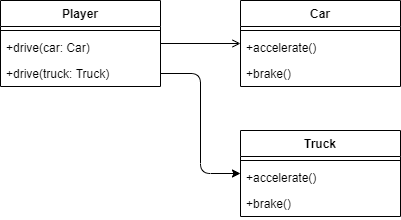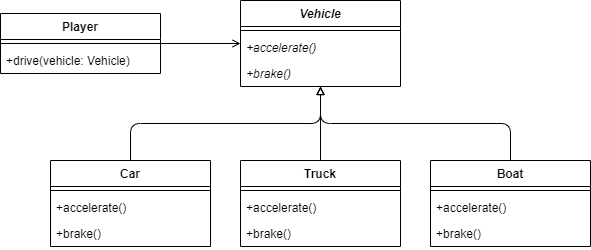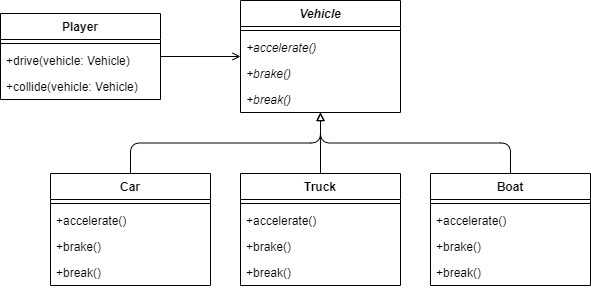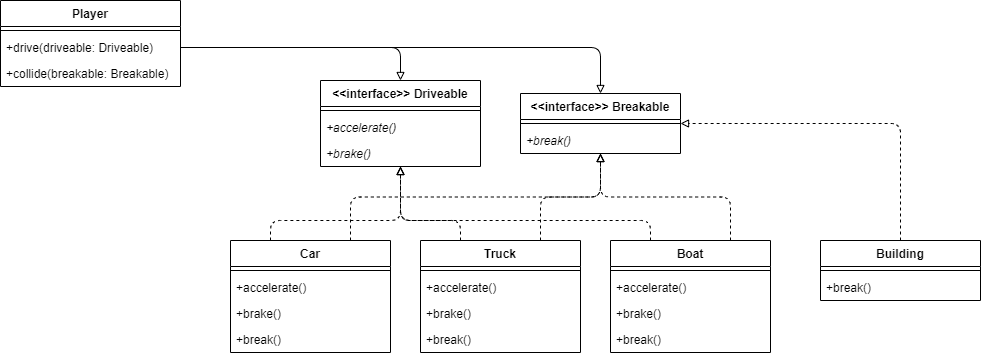1. 引言
刚成为软件开发者的初期,我们大多数人写的代码都是“面向实现”的。
但随着经验的积累,我们逐渐意识到“面向抽象”和“面向接口”编程的重要性。这种思维的转变,让我们写出的代码更加灵活、可维护,也更符合软件设计的最佳实践。
本文将解释“面向接口编程”的含义,并通过一个游戏开发的案例,展示其优势与实现方式。
2. 案例分析
为了更直观地说明问题,我们假设正在开发一款名为《大车盗窃》的游戏。任务之一是让角色可以驾驶各种交通工具。
2.1. 面向实现编程
最开始,我们可能直接创建两个类:Player 和 Car:

我们只需调用 Player.drive(Car) 方法即可。这个实现简单直接,也确实能跑起来。
但紧接着需求来了:角色不仅需要驾驶汽车,还要驾驶卡车。
于是我们新增 Truck 类,并添加 Player.drive(Truck) 方法:

继续扩展,需求又要求支持船只、飞机、自行车……总共 31 种可驾驶对象。
如果继续这种“面向实现”的方式,代码会迅速膨胀,维护起来也变得困难。
2.2. 使用抽象类
我们意识到必须改变设计方式。于是引入抽象类 Vehicle,作为所有交通工具的基类:
public abstract class Vehicle {
public abstract void drive();
}
然后让 Car、Truck、Boat 等类继承它,并统一通过 Player.drive(Vehicle) 调用:

这样我们只需一个 drive() 方法,就能支持所有类型的交通工具。
接下来,需求又要求在碰撞事件中支持“车辆受损”功能。我们添加了 break() 和 brake() 方法:

但这两个方法名太相似,容易混淆,导致 bug 频出。我们开始思考:是否可以将这些行为拆分出来?
2.3. 使用多个接口
Java 不支持多继承,但我们可以通过接口实现类似功能。于是我们定义两个接口:
public interface Driveable {
void drive();
}
public interface Breakable {
void break();
}
让 Car、Truck 等类根据需要实现这些接口:

接下来,需求又来了:建筑也需要“受损”功能。我们只需让建筑类实现 Breakable 接口即可:

不需要改动 Player 类,也不需要重写大量逻辑,一切就绪。✅
2.4. 案例总结
我们使用了三种不同的编程方式:
| 方式 | 描述 | 问题 |
|---|---|---|
| 面向实现 | 直接依赖具体类 | 代码耦合高,维护困难 |
| 面向抽象 | 使用抽象类 | 抽象粒度不够细,行为混合 |
| 面向接口 | 多个接口定义不同行为 | 更灵活,更解耦 |
面向接口编程的本质是:通过接口定义行为契约,而不是依赖具体实现。
3. 面向接口编程的影响
3.1. 统一的方法命名
接口定义了统一的行为契约。比如所有交通工具都必须实现 drive() 方法。这样我们就不必担心 accelerate()、speedUp()、goFaster() 等方法名混乱的问题。
✅ 接口强制统一方法名,避免行为定义不一致。
3.2. 实现细节隐藏
接口隐藏了实现细节,只暴露必要的行为。这样做的好处是:
- 降低耦合度
- 提高代码可维护性
- 更容易理解整体逻辑
比如 JDBC API 只暴露接口,具体实现由驱动提供,应用层无需关心。
3.3. 更好的可测试性
接口使得依赖注入和 mock 更容易。比如我们可以在测试中使用 mock 对象代替真实实现,而无需修改业务逻辑。
✅ 接口让单元测试更容易,mock 更灵活。
3.4. 支持多种实现
接口允许我们随时更换实现,而不影响调用方。比如我们可以将数据访问层抽象为接口,之后随时从 MySQL 切换到 Neo4j,而无需修改业务逻辑。
✅ 接口解耦,实现可插拔。
4. 与 SOLID 原则的关系
面向接口编程天然支持多个 SOLID 原则:
| 原则 | 关联点 |
|---|---|
| 单一职责原则 (SRP) | 接口定义单一职责,类实现清晰 |
| 开闭原则 (OCP) | 新增实现不修改已有逻辑 |
| 里氏替换原则 (LSP) | 子类必须能替换父类(需设计时注意) |
| 接口隔离原则 (ISP) | 定义小而精的接口,避免“胖接口” |
| 依赖倒置原则 (DIP) | 依赖接口而非实现,核心思想之一 ✅ |
5. 相关设计模式
面向接口编程是很多设计模式的基础,比如:
- 工厂模式:用于创建接口的实现
- 代理模式:封装接口实现,添加额外逻辑
- 策略模式:根据接口动态切换行为
- 适配器模式:兼容不同接口实现
使用 Spring、CDI、Guice 等框架可以更方便地管理接口与实现的绑定。
✅ 接口是设计模式的基础,也是实现松耦合的关键。
6. 总结
面向接口编程对新手来说可能显得繁琐,但它是构建高质量、可维护、易扩展系统的基石。
它带来的好处包括:
- ✅ 更低的耦合度
- ✅ 更高的可测试性
- ✅ 更灵活的实现替换
- ✅ 更清晰的代码结构
当然,它也需要我们具备良好的抽象能力、接口设计能力和一定的架构经验。
记住:不要为了抽象而抽象,而是为了业务逻辑的清晰与灵活而抽象。